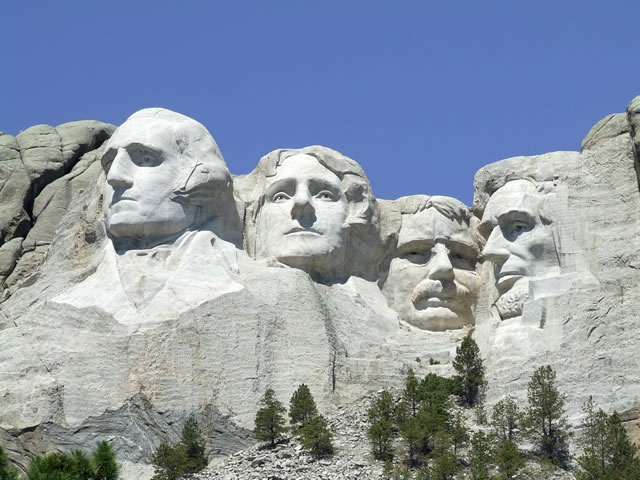 |
Canku Ota
|
 |
|
(Many Paths)
|
||
|
An Online Newsletter
Celebrating Native America
|
||
|
May 1, 2009 - Volume
7 Number 5
|
||
|
|
||
|
Mt. Rushmore Continues
To Become More Native Friendly
|
||
|
by Babette Herrmann,
Indian Country Today correspondent
|
||
|
credits: photo courtesy
of the National Park Service
|
|
MOUNT RUSHMORE NATIONAL MEMORIAL, S.D. – When Gerard Baker, an enrolled member of the Three Affiliated Tribes, was hired as the superintendent at Mount Rushmore nearly four years ago, not much, if anything at all reflected the rich history of American Indians in the Black Hills. Baker, the proud guardian of the behemoth granite shrines of presidents’ George Washington, Thomas Jefferson, Theodore Roosevelt and Abraham Lincoln, said one of his priorities after he came aboard was to bring the Native story to life. “That story wasn’t being told. A part of my position here is making everyone feel welcome.” This desire, along with plenty of input, led to the creation of the Heritage Village exhibit in 2008, located off the Presidential Trail. It features three tipis, each one representing the Lakota, Dakota and Nakota nations. Last
summer, Native storytellers, artisans and hoop dancers engaged visitors,
and the park plans on doing it all over again this summer season.
Where park visitors sit, stand or walk, the ancestors of the Sioux freely trekked before being forced onto reservations starting in the mid-1800s. For Baker, the exhibit was the logical step forward to provide an area where inquisitive visitors can learn about the Sioux. “It’s probably the most popular exhibit we have right now. People love to go there and ask questions.” Natives have a long history of disliking Mount Rushmore for its tribute to four white men carved into what once was their homeland, a reminder of losing the Black Hills when the federal government broke the Fort Laramie Treaty of 1868, history that Baker said needs to be shared with visitors. “I want everybody to understand that this is a part of American history, and we need to show all sides of that story. We need to talk about the forced removal of American Indians from here, and being forced on to reservations, and what happened with the breaking of the Fort Laramie Treaty.” The creation of the Heritage Village exhibit was also influenced by a common question asked by visitors, “What happened to the Native Americans?” Shortly after Baker started as superintendent, he and his staff visited South Dakota tribes, and asked elders and members for input on what could be done to educate visitors on Natives. He said that it’s thanks to those meetings that Mount Rushmore has a more Native-friendly environment, and more Natives than ever are visiting the park. This summer elders are scheduled to share stories about the past and discuss contemporary Native issues. The park hosted an elders’ summit in January 2008. Baker said that since relations with tribes have improved, a group from the Pine Ridge Indian Reservation has held a retreat there for the second year in a row, and employment of Natives at the park has grown to an all time high. Meanwhile, there are plans to carve out a new trail, temporarily given the name Yellow Wolf, Baker’s Indian name. According to the National Park Service, the trail will feature a core loop system around Mount Rushmore with scenic vistas, spur trails and interpretive stops. When completed, it will sprawl 6 to 10 miles. Baker said his staff gave the trail his name, and an official name will likely be determined in a contest for sixth through ninth grade South Dakota students. He would like the park to host a youth summit this summer, but those plans are still in the early stages. “What I am trying to do is bring in as much youth as possible, so they can start learning who they are, and start sharing that with visitors.” The park staff is also in the process of revamping its General Management Plan to reflect the diversity that makes up the park today and a guideline to map out goals for the next 15 to 20 years. The last GMP was updated in 1980. Mount Rushmore National Memorial draws nearly three million visitors a year from across the country and around the world. It was named after Charles E. Rushmore, an attorney from New York, during an 1885 expedition. The project was the creation of sculptor Gutzon Borglum, along with 400 men and women. It broke ground in 1927 and was completed in 1941. |
|
|
||
|
|
||
| Canku Ota is a free Newsletter celebrating Native America, its traditions and accomplishments . We do not provide subscriber or visitor names to anyone. Some articles presented in Canku Ota may contain copyright material. We have received appropriate permissions for republishing any articles. Material appearing here is distributed without profit or monetary gain to those who have expressed an interest. This is in accordance with Title 17 U.S.C. Section 107. | ||
|
Canku Ota is a copyright ©
2000, 2001, 2002, 2003, 2004, 2005, 2006, 2007, 2008, 2009 of Vicki
Barry and Paul Barry.
|
||
 |
 |
|
|
The "Canku
Ota - A Newsletter Celebrating Native America" web site and
its design is the
|
||
|
Copyright ©
1999, 2000, 2001, 2002, 2003, 2004, 2005,
2006, 2007, 2008 of Paul C.
Barry.
|
||
|
All Rights Reserved.
|
||
